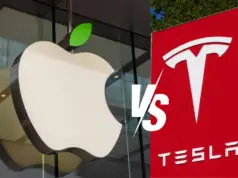It’s awesome how you can record and save what’s happening in front and behind your car with the cameras.
But what if one day your dashcam stops working and shows you an error message like “Dashcam unavailable” or “Check USB drive”? That would suck, wouldn’t it?
How would you fix it and get your dashcam back?
Don’t worry, I’m here to help.
In this article, I’ll tell you why your Tesla dashcam might be unavailable and how to fix it. I’ll also give you some tips and tricks to avoid this problem in the future.
Why Tesla Dashcam Unavailable?
There are several possible reasons why you are seeing the error message ‘Dashcam unavailable Check USB Drive’ on your Tesla. Some of them are:
1 The USB drive is not formatted correctly or has corrupted files.
2. The USB connection is loose or disconnected. You can try to open the glove box, unplug the USB stick, and plug it back in.
3. The USB drive is not compatible with Tesla’s dashcam feature.
4. The software update has caused a bug that affects the dashcam feature.
How to Fix Tesla Dashcam Unavailable Issue?
What causes this problem and how can it be fixed? Here are some possible reasons and solutions for the Tesla dashcam unavailable issue.
#1. Use a Compatible USB Drive
Not all USB drives are compatible with the dashcam feature. Tesla recommends using a USB 3.0 drive with a minimum of 32 GB of storage and a write speed of at least 4 MB/s.
Some USB 2.0 drives may work, but they may not be able to keep up with the high data rate of the dashcam.
To check if your USB drive is compatible, you can use a computer to test its speed and format. You can also try using a different USB drive to see if the problem persists.
I picked up this amazing Samsung SSD for the dashcam recording on Amazon, and let me tell you, it’s a game-changer! I’ve had folks constantly asking me for the best SSD for their Tesla dashcam, and I can confidently say, that this Samsung gem is the way to go.
#2. Format the USB Drive For Space
The dashcam feature automatically deletes the oldest video files when the USB drive reaches its capacity, but sometimes this process may fail or take too long.
This can cause the dashcam to stop recording or saving new files.
To avoid this issue, you should regularly check the available space on your USB drive and delete any unnecessary files.
You can also use a larger USB drive or enable the option to automatically delete clips on honk, which will delete the most recent 10-minute video file when you honk the horn.
#3. Check Format Setting
The USB drive that you use for the dashcam must be formatted in a specific way to work with the Tesla software.
The file system must be FAT32 (Windows) or exFAT (Mac), and the drive must have a folder named TeslaCam at the root level.
If the USB drive is not formatted correctly, the dashcam may not recognize it or access it.
To format your USB drive, you can use a computer or use the built-in format option in your Tesla.
To format your USB drive in your Tesla, go to Controls > Safety & Security > Format USB Device > Format. This will erase all the data on your USB drive and create a TeslaCam folder for you.
#4. Rebooting your Tesla system
Sometimes, the Tesla dashcam may not work because of a temporary glitch or error in the system.
Rebooting your system can help clear the cache and memory, and reset the software to its normal state.
To reboot your system, you need to press and hold both steering wheel buttons until the screen goes black and restarts.
This may take a few minutes, and you should not touch any pedals or buttons during the process.
After the reboot, you can check if your dashcam is working again.
#5. Updating Tesla software
Tesla regularly releases software updates that improve the performance and functionality of its vehicles. Some of these updates may fix bugs or issues that affect the dashcam feature.
To update your software, you need to connect your car to a Wi-Fi network and check for updates in Controls > Software. If there is an update available, you can download and install it.
You may need to park your car and keep it plugged in during the update. After the update, you can check if your dashcam is working again.
How to fix this ‘Dashcam unavailable Check USB Drive’ error?
There are several possible ways to fix this ‘Dashcam unavailable Check USB Drive’ error, depending on the cause of the problem. Here are some suggestions you can try:
1) Format the USB drive in your Tesla by going to Controls > Safety & Security > Format USB Device > Format
2) Open the glove box, unplug the USB stick, and plug it back in.
3) Restart the screen
You may encounter an error while formatting a USB drive for the dashcam feature in Tesla Model 3. Don’t go panic.
Error while formatting a USB drive For Dashcam?
When formatting a USB drive for use with the Tesla Model 3 dashcam, you may encounter an error message that reads, “Error: Formatting not completed. Please insert the drive again.”
This error message indicates that the drive was not formatted correctly and needs to be formatted again.
Why USB is not formatted?
The error can occur due to several reasons, including:
1. Incorrect formatting
2. Corrupted file system
3. Incompatible USB drive
4. Insufficient storage space
5. USB drive write-protected
How to Properly Format USB without any Error?
To resolve the error while formatting a USB drive for the Tesla Model 3 dashcam, follow the steps below:
Step 1: Check USB drive compatibility
1. Minimum capacity: 32 GB
2. Recommended read/write speeds: 100 MB/s or higher
3. File system: FAT32
4. USB drive format: MBR partition scheme
Step 2: Format the USB drive
If your USB drive meets the recommended specifications, but the formatting error persists, try formatting the USB drive using the following steps:
1. Connect the USB drive to your computer.
2. Open File Explorer and locate the USB drive.
3. Right-click on the USB drive and select “Format.”
4. In the Format window, select the file system as “FAT32.”
5. Select the allocation unit size as “Default allocation size.”
6. Uncheck the “Quick Format” option.
7. Click on “Start” to begin the formatting process.
8. Wait for the formatting process to complete.
Step 3: Remove write-protection
If the USB drive is write-protected, you will not be able to format or write to the drive. To remove write protection, use the following steps:
1 Connect the USB drive to your computer.
2. Open Command Prompt as an administrator.
3. Type “diskpart” and press Enter.
4. Type “list disk” and press Enter.
5. Identify the disk number of the USB drive.
6. Type “select disk [disk number]” and press Enter.
7. Type “attributes disk clear read-only” and press Enter.
8. Type “exit” and press Enter.
Step 4: Format the USB drive using Tesla Model 3
Once you have formatted the USB drive and removed any write protection, you can try formatting the USB drive again using Tesla Model 3’s built-in formatting feature.
Follow the steps below to format the USB drive using Tesla Model 3:
1. Connect the USB drive to Tesla Model 3’s front USB port.
2. On the touchscreen, go to Controls > Safety & Security > FORMAT USB DEVICE.
3. A pop-up window will appear with a warning message. Read the message carefully and click “FORMAT” if you agree.
4. Wait for the formatting process to complete.
5. Once the formatting is complete, a message will appear confirming the format was successful.
Step 5: Check the USB drive
After formatting the USB drive using Tesla Model 3, check to ensure that it is working correctly. To do this, follow the steps below:
1. Eject the USB drive from Tesla Model 3 by tapping the “EJECT” button on the touchscreen.
2. Remove the USB drive from the car and connect it to your computer.
3. Ensure that the USB drive is visible and that the file system is FAT32.
4. Create a new folder on the USB drive and name it “TeslaCam.”
5. Eject the USB drive from your computer and connect it back to Tesla Model 3’s front USB port.
6. Wait for the dashcam icon to appear on the touchscreen, indicating that the dashcam is recording.
7. Drive the car and check if the dashcam is recording correctly.
Conclusion
The Tesla dashcam is a valuable feature that can help you record and save important events on the road.
However, sometimes it may not work as expected and show an error message saying “Dashcam unavailable” or “Check USB drive”.
This can be caused by various factors, such as using a wrong or full USB drive, having an incorrect format setting, or having a software bug.
Fortunately, most of these problems can be solved by following some simple steps, such as formatting your USB drive, checking its space and speed, rebooting your system, or updating your software.
If these solutions do not work, you may need to contact Tesla for further assistance.
We hope this article has helped you understand why your Tesla dashcam may be unavailable and how to fix it. If you have any questions or comments, please feel free to share them below.





